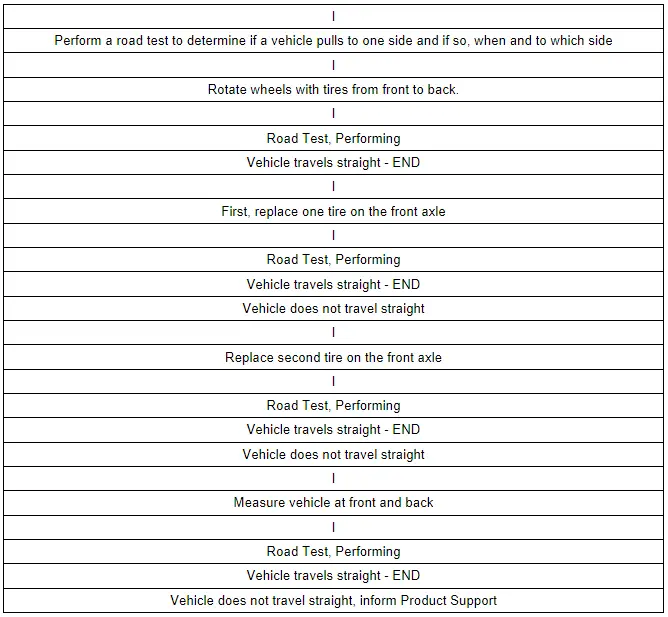Audi Q7: Vehicle Pulls to One Side
General Information
Perform a road test to determine if a vehicle pulls to one side and if so, when and to which side. If the vehicle pulls to one side, see procedure → Chapter "Corrective Action when Vehicle Pulls to One Side".
If the vehicle alignment is measured, submit the measurement printout and the complaint report with the tire.
Manufacturer's tolerances can lead to taper in the tire construction. This results in a side force when the tire rolls, which acts directly on the suspension and can therefore lead to vehicle self-steering behavior. Targeted rotation of the wheels can balance out this self-steering behavior.
Taper
Taper is caused by slightly offsetting the tread and/or the belt by a few tenths of a millimeter from the geometric center of the tire. Taper cannot be recognized visually nor can it be measured with workshop equipment.

1 - Bead
2 - Shoulder
3 - Tread
4 - Steel belt
A - Geometric center of tire
B - Actual position of belt. It can be offset to inside or outside.
Shown out of proportion to provide a better illustration.

1 - Belt/tread offset
The offset produces differences in rigidity of the inner and outer shoulders of the tire, which lead to differing forces on the contact patch. Due to this, the belt and tread will not be pressed against the road surface with the same force (F1, F2). A taper forms. The resulting force (force of taper Fk) can become so large depending on speed, that the vehicle pulls to one side.
If the force (Fk) on one wheel of the axle is, for example, 50 Newton and on the other wheel also 50 Newton, and both forces are exerted in the same direction, the forces are additive. Reversing a tire on the rim can compensate for the pulling because the forces then act against each other.
Because the direction in which the force of taper is exerted is not visible at the tire, only road tests and targeted rotation of wheels and tires can establish which tires cause the pulling.
The tire consists of numerous components and materials which are vulcanized to a single part at the end of a complicated manufacturing procedure. This leads to differing construction tolerances which can make themselves noticeable through more or less strong lateral forces (lateral forces of taper). These forces can also develop in new tires.
One-sided pulling on front axle:
Pulling to one side can be caused by the suspension. However, experience shows that in 90% of all complaints, the tires cause pulling to one side.
One-sided pulling during normal driving behavior:
On a straight, level road surface, the vehicle wants to pull to one side at a constant speed or with moderate acceleration. A force can be felt at the steering wheel.
One-sided pulling during strong accelerating:
Pulling to one side during fast acceleration is, in part, due to the design of vehicles with front wheel drive. Various frictional conditions of left and right wheels, for example, possible irregularities in the road surface (pot holes) and consequently varying adhesion to ground have a substantial influence on the handling characteristics. This does not constitute a complaint in the sense of warranty coverage.
Corrective Action when Vehicle Pulls to One Side
Test conditions before and during the road test:
- Check all suspension components on front and rear axle for damage.
- Check tire pressure and correct if necessary.
- Check the tires for external damage. Holes, cuts, bulges in the side wall, flat spots from braking and/or damage to the tread.
- Ask the customer if a tire had been damaged by a nail or similar object and perhaps repaired by a tire dealer. You may have to replace such tires.
- Check tires for even wear and tread depth.
- Are all tires of the same type, manufacture and tread pattern?
- If the tires are non-directional, ensure that all DOT classifications on the tire face outwards. It may be that the vehicle's wheels and tires were already changed around at an earlier date.
- Are the tire brands factory-approved as initial equipment?
- For the road test, use a level, straight driving surface that does not slope off to one side and does not have ruts.
- Perform the road test with the customer under the conditions specified above. The customer should demonstrate the problem.
 Note
Note
There should not be any side wind when road test takes place.
If the complaint is justified, it is recommend to rotate the wheels and tires as described on the following pages.
Before beginning, observe the following notes, otherwise all effort will be for nothing!
- Identify tires and wheels before the first rotation.
- After rotating wheels or reversing the tire on its rim, observe very carefully how the vehicle behaves during the road test. Note what was replaced and how.
- The intensity or any possible change to the one-sided pulling should be assessed.
- To do this, it is absolutely essential that the road tests are always performed by the same person on the same road. It is best to drive the test course in both directions.
- Replacing a tire with a new one does not ensure that the pulling to one side is corrected. Therefore, it is recommended to perform a targeted exchange of the wheels as described below.
- If there are large differences in the tread depth of the tires on the front and rear axles, the tires with the deeper tread should always be mounted on the front axle.
Targeted Rotating of Wheels for Non-Directional Tires

Wheels, Targeted Rotating for Directional Tires
Be careful not to scratch off the glued- on wheel trim on these rims.
The surface of the wheel trim is very sensitive.
The rim will have be replaced if the wheel trim is damaged.
The wheel trim cannot be replaced.



